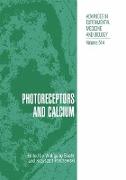- Start
- Photoreceptors and Calcium
Photoreceptors and Calcium
Angebote / Angebote:
2 The role of Ca+ as an internal messenger in visual transduction of vertebrate and invertebrate organisms has been explored intensely in the recent past. Since the 2 early 1970s, calcium ions and cyclic GMP (whose levels are controlled by Ca+ in vertebrates) have been recognized as important second messengers. Particularly in 2 the last decade, however, the role of Ca+ in visual transduction has been re-evalu ated and a proliferation of research has documented a multiplicity of roles. 2 It is now evident that Ca+ modulates phototransduction by acting at several 2 sites through a host of small Ca+ -binding proteins. For example, in phototransduction 2 of vertebrates, Ca+-free forms of guanylate cyclase activating proteins (GCAPs) activate guanylate cyclase, modulating levels of cOMP, a key event in the return of photoreceptors to pre-bleach conditions. Defects in genes encoding guanylate cy clase or guanylate cyclase activating proteins lead to severe diseases of the retina (e. g. , Leber congenital amaurosis, rod/cone dystrophy, or cone dystrophy), thus em phasizing the important role of these proteins in phototransduction. Similarly, mu 2 tant genes encoding cation or Ca+ channels (cyclic nucleotide-gated cation chan 2 nels located in the cell membrane and L-type voltage-gated Ca+ channels located at the synapse of photo receptors) lead to retinitis pigmentosa or congenital stationary night blindness. In phototransduction of invertebrate organisms (e. g. , Drosophila 2 and Limulus), the role of Ca+ is similarly central, but distinct, from that of vertebrates.
Lieferbar in ca. 20-45 Arbeitstagen




